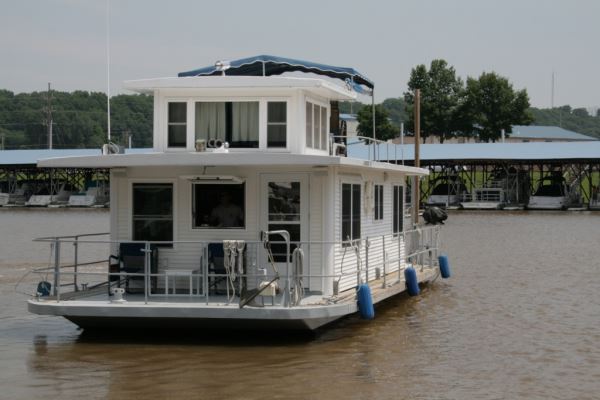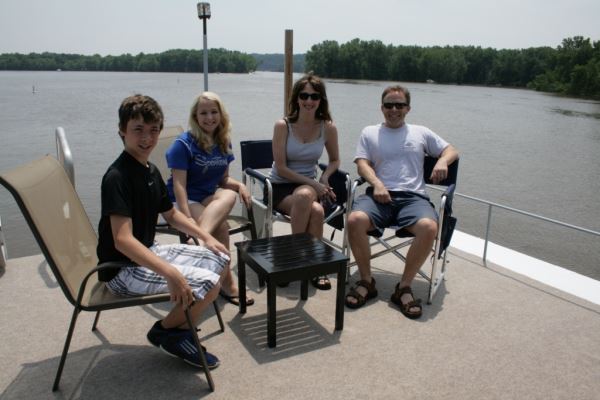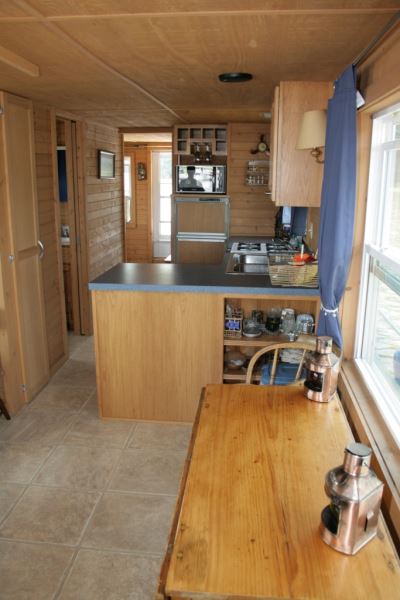 Some folks dream about owning a houseboat for years before they actually buy one. A lot of times, though, that first boat is then sold as the owners move up and on.
Some folks dream about owning a houseboat for years before they actually buy one. A lot of times, though, that first boat is then sold as the owners move up and on.
That couldn't be further from the way getting into houseboating worked out for Tom and Char Woodward of Dubuque, Iowa. In some respects, their houseboat ownership story goes all the way back to 1952. That is when Tom's great-grandfather commissioned Dubuque Boat and Boiler Works to build a steel houseboat he named Driftwood. At about 31 feet long and 14 feet wide, it was described as more of a floating barge.
Then their son Bob fell in love with houseboating but decided he wanted something bigger and better, so in 1958 he had the same company build him a 16- by 46-foot model. Eventually, he and his wife Jeanne spent almost every weekend on her from early April to November and sometimes had to break ice to get back into their marina. They also cruised that boat extensively not only on the Mississippi River, but also on the Illinois, Missouri and Ohio Rivers, frequently cruising for several weeks.
They passed their love of houseboating down to grandson Tom who began piloting for them when he was a teenager. His 'deckhand-in-training' was his girlfriend Char who later became his wife.
In 2002, Tom's grandparents officially transferred Lets, which was documented at that time to Tom and Char. The boat was named because Jeanne was frequently heard to say, “Let's go here,” or “Let's go there,” and even, “Let's do that.”
Next Generation
Now the Woodwards are passing their love of houseboating on the same boat down to their children, Rachael, 14, and Jake, 12.
What makes all this possible is that the boat was originally well-designed and built then well maintained and loved by several generations of the same family.
Built sturdily by Dubuque Boat and Boiler and estimated to weigh at least 25 tons, Tom guesses the hull is a quarter-inch thick in places. On top of that sturdy foundation are some unique design features and a family-friendly layout.
There is a single helm station centered in the middle of the forward lounge, a mid-cabin galley and head and another lounge in the aft area. Both lounges have hide-a-beds.
 A major attraction for the young folks aboard, and sometimes even the adults, is a pilothouse-type enclosure, or cupola, that is reached from the forward lounge by a trapdoor in the ceiling or through a small door from the upper deck. An aluminum ladder on the boat serves dual purpose as a way to climb into the enclosure and a beach-boarding ladder. Over the years there have also been some creative approaches that parents have used to get their children into the enclosure. Tom recalls his father “just tossing me up there.”
A major attraction for the young folks aboard, and sometimes even the adults, is a pilothouse-type enclosure, or cupola, that is reached from the forward lounge by a trapdoor in the ceiling or through a small door from the upper deck. An aluminum ladder on the boat serves dual purpose as a way to climb into the enclosure and a beach-boarding ladder. Over the years there have also been some creative approaches that parents have used to get their children into the enclosure. Tom recalls his father “just tossing me up there.”
With windows on all sides and the hatch below secured, the entire 8- by 10-foot area is covered with foam that allows for a number of sleeping arrangements. Up to six children have slept up there at one time and it has also been a frequent spot for hunkering down while playing hide and seek.
Design Quirks
The way the boat has always been used is also connected to a couple of original design features. While it gets taken to a beach now and then, a unique anchoring/positioning system and its 18-inch draft make anchoring out the preference. With its I/Os tilted up, it can venture deep into the sloughs and backwaters, far from the Mississippi River traffic.
Once there, two 4- by 4-inch lead-tipped spud poles mounted on the stern corners can be hand-winched down into the river bottom. Originally, there were poles on all four corners of the boat, but the front ones were removed in the 1980s when the bow was reworked. Davits are positioned next to the remaining ones for hoisting a chase boat.
Tom says the advantages are that they can position the boat for the best view regardless of the current and when the current has a chop that creates a hull slap, they simply maneuver the boat so there is none.
Yet another of the boat's design quirks are the two outriggers hinged to each side deck. When swung out and locked in place perpendicular to the boat, a chase boat's bow can be attached,. With the stern also tied off, the small boat can either moor there when anchored or securely ride side-saddle when traveling.
 Home Improvement
Home Improvement
In late 2003, the Woodwards decided it was time for some improvements. Their first thought was just to install some new exterior siding and windows, but a friend pushed them to consider a more thorough upgrade. After thinking about it and realizing they were into houseboating with this boat for the long haul, they agreed to a more extensive project.
When Tom, his father-in-law, a good friend and a neighbor took the interior back to the studs, they were pleased to find several things. First was that there was no rot so it wasn't necessary to replace any of the studs or framing. Second was that the wiring was sound and adequate and third was that the original copper plumbing was still in good shape.
The boat was carefully insulated. Then carpenters put on new rough cut plywood paneling and used some of the original mahogany and hard wood to trim everything out. The head got a new electric toilet and both that area and the galley got new cabinets, counters, and faucets.
Because the refrigerator runs on AC/DC or propane and needs to be vented, they installed a small computer fan to move air through an intake and exhaust line for ventilation. Propane is also used for two wall-mounted propane heaters. One small, wall-mounted AC easily handles the cooling chores.
“The boat heats up or cools down quickly with these,” Tom says.
The exterior got new vinyl windows and siding and the cupola got a new roof. A couple of metal hatch covers were also rebuilt along with the aft davits.
The hull was sandblasted inside and out before being re-painted. The mechanical work was handled by Arnie McDowell, who has serviced the boat for years and is the owner of Mid-Town Marine in East Dubuque, Ill. He installed two new 5.0L MerCruiser, Bravo II outdrives and new instrumentation. These are the third set of engines, replacing the V-8s that were installed in the 1970s to replace the original Gray Marine 70hp engines.
Part of the mechanical upgrade is a feature Tom really likes—a wireless, remote control auto-pilot.
“I love it,” he says. “It lets me be with people anywhere on the boat.”
For the times he does pilot from inside, they replicated the original front window that swings up and hinges for ventilation.
But because the boat has so many memories and family ties, they decided to keep much of the original touches. Both hide-a-beds stayed, as did the silverware and most of the dishes, along with many of the wall hangings.

One is a photo of the original construction, one is the original documentation certificate and another is a framed $1 silver certificate that was given to Tom's grandfather, Bob Sr., as a joke/gift as the first dollar toward the commissioning of the boat.
There is also the original radio license and that is tied to the fact that the boat had a state-of-the-art communication system early on. Tom says his grandfather loved electronic gadgets and as owner of a communication business, installed ship to shore telecommunications equipment on the boat. To place a call, they'd call grandpa's company, TelCom, on channel 16 of the marine radio who would then respond and switch them to a working channel. Then a land line would be established and TelCom would call the number requested and when that party answered, would link the shore party and the boat together on the VHF. After the party on shore hung up, the people on the boat would thank TelCom and inform them they were 'clear.'
That was the technology then and this is now, but Lets' main function has not changed one bit. She still serves as a place for the Woodward family and their friends to come together and enjoy time on the water while making houseboating memories.
Dubuque Boat and Boiler Works
The Dubuque Boat and Boiler Works dates back to 1851 when it was founded as the Iowa Iron Works. In 1895 operations were moved to the Ice Harbor there and in 1905, it was reconstructed as Dubuque Boat and Boiler Works. It specialized in boilers and transport boats.
In WWII, they built an estimated 20 military vessels including torpedo boats. Later, they added excursion and passenger boats to the work boats they built.
In the 1950s, they offered a line of semi-custom houseboats called the Voyager. They were usually 16 by 42 feet, boxy, with construction of 3/16 inch steel and weighed around 20 tons. The records of the number of those built is not available. Production of all boats ended in 1972.